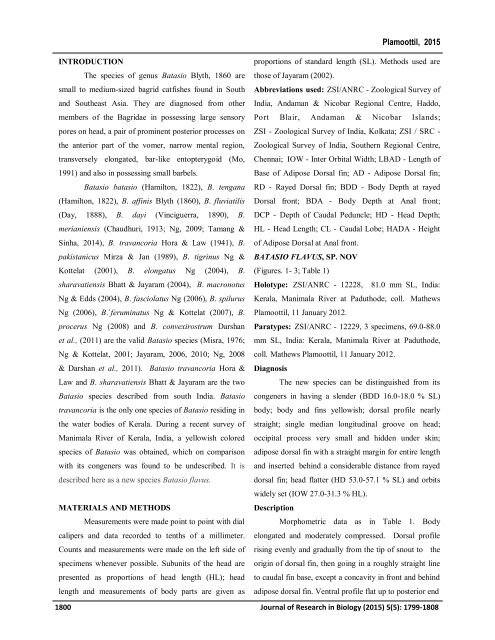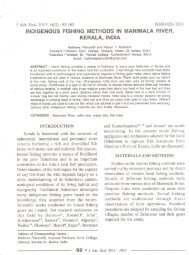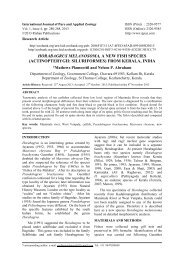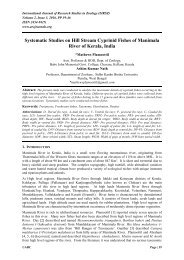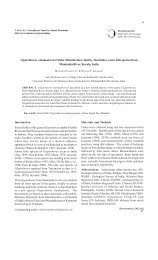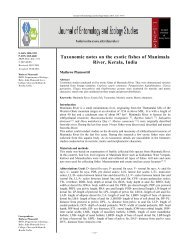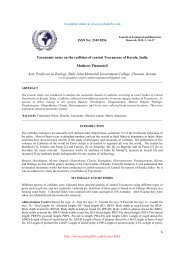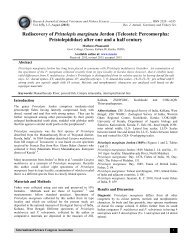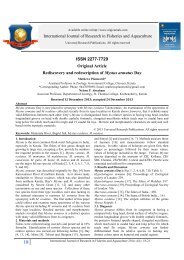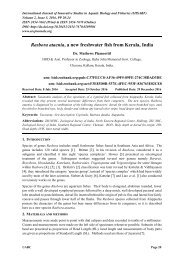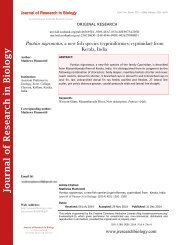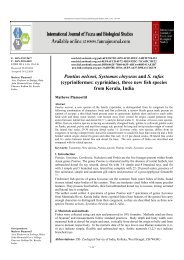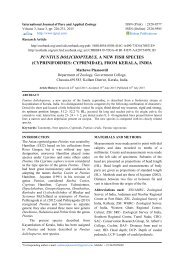You also want an ePaper? Increase the reach of your titles
YUMPU automatically turns print PDFs into web optimized ePapers that Google loves.
Plamoottil, 2015<br />
INTRODUCTION<br />
The species of genus <strong>Batasio</strong> Blyth, 1860 are<br />
small to medium-sized bagrid catfishes found in South<br />
and Southeast Asia. They are diagnosed from other<br />
members of the Bagridae in possessing large sensory<br />
pores on head, a pair of prominent posterior processes on<br />
the anterior part of the vomer, narrow mental region,<br />
transversely elongated, bar-like entopterygoid (Mo,<br />
1991) and also in possessing small barbels.<br />
<strong>Batasio</strong> batasio (Hamilton, 1822), B. tengana<br />
(Hamilton, 1822), B. affinis Blyth (1860), B. fluviatilis<br />
(Day, 1888), B. dayi (Vinciguerra, 1890), B.<br />
merianiensis (Chaudhuri, 1913; Ng, 2009; Tamang &<br />
Sinha, 2014), B. travancoria Hora & Law (1941), B.<br />
pakistanicus Mirza & Jan (1989), B. tigrinus Ng &<br />
Kottelat (2001), B. elongatus Ng (2004), B.<br />
sharavatiensis Bhatt & Jayaram (2004), B. macronotus<br />
Ng & Edds (2004), B. fasciolatus Ng (2006), B. spilurus<br />
Ng (2006), B.`feruminatus Ng & Kottelat (2007), B.<br />
procerus Ng (2008) and B. convexirostrum Darshan<br />
et al., (2011) are the valid <strong>Batasio</strong> species (Misra, 1976;<br />
Ng & Kottelat, 2001; Jayaram, 2006, 2010; Ng, 2008<br />
& Darshan et al., 2011). <strong>Batasio</strong> travancoria Hora &<br />
Law and B. sharavatiensis Bhatt & Jayaram are the two<br />
<strong>Batasio</strong> species described from south India. <strong>Batasio</strong><br />
travancoria is the only one species of <strong>Batasio</strong> residing in<br />
the water bodies of Kerala. During a recent survey of<br />
Manimala River of Kerala, India, a yellowish colored<br />
species of <strong>Batasio</strong> was obtained, which on comparison<br />
with its congeners was found to be undescribed. It is<br />
described here as a new species <strong>Batasio</strong> <strong>flavus</strong>.<br />
MATERIALS AND METHODS<br />
Measurements were made point to point with dial<br />
calipers and data recorded to tenths of a millimeter.<br />
Counts and measurements were made on the left side of<br />
specimens whenever possible. Subunits of the head are<br />
presented as proportions of head length (HL); head<br />
length and measurements of body parts are given as<br />
proportions of standard length (SL). Methods used are<br />
those of Jayaram (2002).<br />
Abbreviations used: ZSI/ANRC - Zoological Survey of<br />
India, Andaman & Nicobar Regional Centre, Haddo,<br />
Port Blair, Andaman & Nicobar Islands;<br />
ZSI - Zoological Survey of India, Kolkata; ZSI / SRC -<br />
Zoological Survey of India, Southern Regional Centre,<br />
Chennai; IOW - Inter Orbital Width; LBAD - Length of<br />
Base of Adipose Dorsal fin; AD - Adipose Dorsal fin;<br />
RD - Rayed Dorsal fin; BDD - Body Depth at rayed<br />
Dorsal front; BDA - Body Depth at Anal front;<br />
DCP - Depth of Caudal Peduncle; HD - Head Depth;<br />
HL - Head Length; CL - Caudal Lobe; HADA - Height<br />
of Adipose Dorsal at Anal front.<br />
BATASIO FLAVUS, SP. NOV<br />
(Figures. 1- 3; Table 1)<br />
Holotype: ZSI/ANRC - 12228, 81.0 mm SL, India:<br />
Kerala, Manimala River at Paduthode, coll. Mathews<br />
Plamoottil, 11 January 2012.<br />
Paratypes: ZSI/ANRC - 12229, 3 specimens, 69.0-88.0<br />
mm SL, India: Kerala, Manimala River at Paduthode,<br />
coll. Mathews Plamoottil, 11 January 2012.<br />
Diagnosis<br />
The new species can be distinguished from its<br />
congeners in having a slender (BDD 16.0-18.0 % SL)<br />
body; body and fins yellowish; dorsal profile nearly<br />
straight; single median longitudinal groove on head;<br />
occipital process very small and hidden under skin;<br />
adipose dorsal fin with a straight margin for entire length<br />
and inserted behind a considerable distance from rayed<br />
dorsal fin; head flatter (HD 53.0-57.1 % SL) and orbits<br />
widely set (IOW 27.0-31.3 % HL).<br />
Description<br />
Morphometric data as in Table 1. Body<br />
elongated and moderately compressed. Dorsal profile<br />
rising evenly and gradually from the tip of snout to the<br />
origin of dorsal fin, then going in a roughly straight line<br />
to caudal fin base, except a concavity in front and behind<br />
adipose dorsal fin. Ventral profile flat up to posterior end<br />
1800 Journal of Research in Biology (2015) 5(5): 1799-1808


